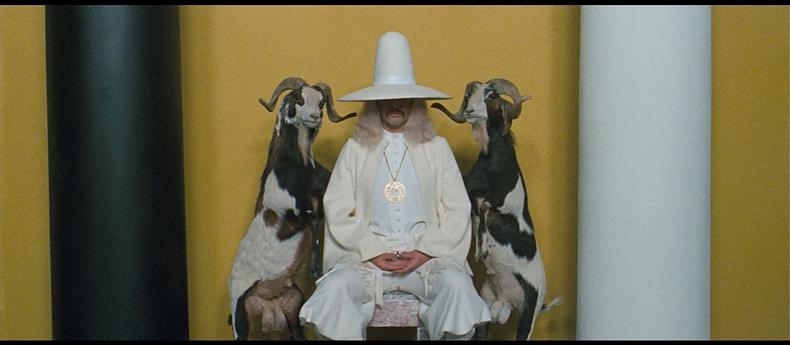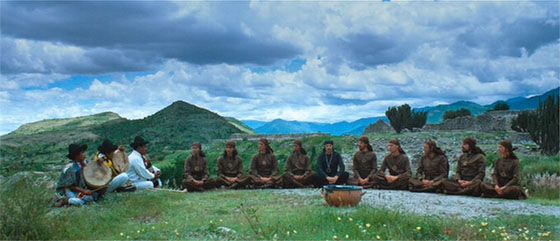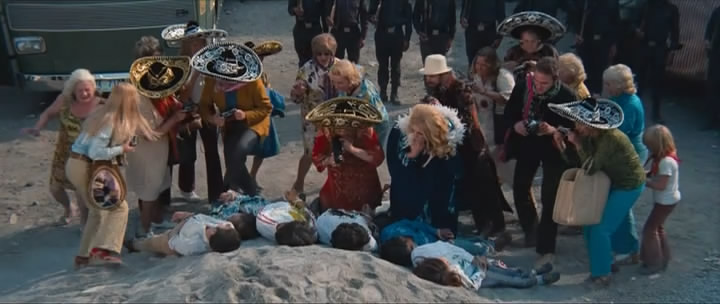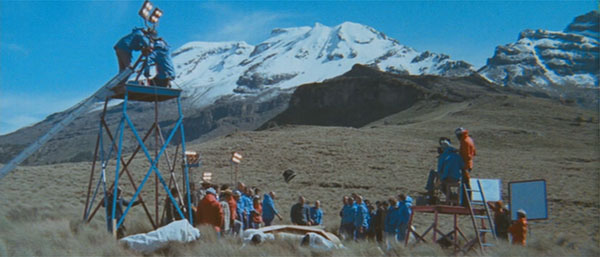6. Alejandro Jodorowsky’s finest hour

Delectably eccentric, purposefully evocative – a peculiar genius? All three of these labels could be pinned directly onto the director, producer, screenwriter and leading actor of “The Holy Mountain”, Alejandro Jodorowsky himself. Half-Chilean and half-French, Jodorowsky has, throughout the span of his now 50-year career, been followed by controversy, intellectual interest, and cult-like followings.
Whether it was his first feature “Fando y Lis” (1967) causing a huge scandal in Mexico and being banned, or his veritable failure to complete a cinematic adaptation of Frank Herbert’s science-fiction epic Dune (1965), Jodorowsky has never been “mainstream” in his methodology, or indeed, his films.
“The Holy Mountain” is, of course, no exception, and in fact is probably the most quintessential film of the bizarre Jodorowsky filmography. Mixing elements of mysticism, vivid surrealist violence, and an examination of Western society, Jodorowsky epitomises his controversial but eternally stimulating style, and executes it with an offbeat precision that has made the 1973 work not only his most popular and acclaimed film, but also one that forever cements his avant-garde and idiosyncratic legacy in the history books of cinema.
7. The Cinematography

Orchestrated by Jodorowsky but shot by Rafael Corkidi, the cinematography and mise-en-scene of “The Holy Mountain” is vital to its execution and success. Corkidi, a frequent collaborator with Jodorowsky, retired from filmmaking in 1978 to focus on the medium on video for the remainder of his career. However, his contributions to the Mexican film industry – through his accomplishments in “El Topo” and “The Holy Mountain” in particular – garnered 2013’s “Ariel de Oro”, Mexico’s top film prize.
In surrealist cinema, visual clarity and quality are essential, as much of the films appeal lies in the bizarre actions and images which we see, rather than the music we hear or the characters we listen to – “The Holy Mountain” has this aesthetic appeal in abundance, primarily thanks to the work of Corkidi under the supervision of Jodorowsky.
At first, the film may seem cluttered, with huge amounts of visual stimulation being crammed into every shot. However, when taken apart and dissected, “The Holy Mountain” is a superbly crafted piece of cinema, with a vividly ranged colour scheme merging with surreal orchestrated action and strong symbolism to create memorable scenes and action for the whole of the film’s 115-minute length.
One scene in particular, when the Thief enters the Alchemist’s tower holding a dagger, shows the skill of Corkidi; a room coloured like a rainbow, with the Alchemist at the centre of it and a clear path for the Thief to follow towards him. One of the few shots in the film that abuses the use of space and distance, but also, for this reason, one of the most distinctive and unique in the whole feature, and in the world of contemporary cinema on a whole.
8. A Spiritual Journey with Strong References to Christianity and High Levels of Symbolism

Whether “The Holy Mountain” commends or condemns religion and Western society is down to personal interpretation; however, it is obvious that Jodorowsky purposefully places religious and societal motifs throughout the piece to add to the mysticism and surreal nature of the whole feature. A scene of a Jesus-like Thief eating waxworks copies of himself (these copies are created in the style of Jesus on the crucifix) can be interpreted as both a criticism of Jesus – that he is potentially narcissistic – and praise of him, that he is an idea that should be literally “digested” as much as possible.
The idea of Jesus being likened to a Thief is controversial in itself, with references to Buddhist spirituality (“The Holy Mountain” can be seen as a parallel to the idea of Nirvana and Enlightenment) and ethical values also being uniquely explored by Jodorowsky. In addition to this, the negative personifications of the eight planets in our solar system can be also seen and represented as the eight followers of the Alchemist. This raises the question – does the Jesus-like Thief figure personify Earth? And if so, as the Thief follows the Alchemist, does this mean that the Alchemist (Jodorowsky) is above Jesus, Christianity, and God himself?
This may seem far-fetched, and potentially it is, but the skill of the symbolism of “The Holy Mountain” lies in its complete ambiguity in its referencing to society and religion, allowing the audience to interpret it for themselves – definitely a psychedelic experience, but perhaps a philosophical one as well.
9. Completely Unique – Both Then, and Now

As an art form, cinema and film will constantly evolve, and it may be completely possible that surrealism may become the mainstream in the near future; David Lynch has already helped push it further toward commercial audiences. For now, however, “The Holy Mountain” remains as bizarre and unique as it was during its own era, a film that is unlikely to ever be reproduced in its sheer abundance of surreal action and provocative sexual violence.
It is well known that Jodorowsky was attempting to alienate himself from the mainstream at the time, with surrealism, to his dismay, becoming more popular. Despite this, it is commendable that even now, nearly 45 years later, nothing with the same cult devotion, delusive imagery, or crazed mixed of violence and beauty has even been attempted, never mind made and released to the public. Still, it shocks and awes new film fans with its absolute surrealistic audacity, creating a fabled reputation for the film itself and its mastermind, the eccentric French-Chilean Jodorowsky.
At the time the work created controversy, as it does today, due its depiction of extreme violence throughout; the 1973 Cannes Film Festival was especially shocked by its brutality and evocation. It still holds this controversial connotation today, but there is no doubt that in its approach and contribution to cinema it is still completely unique, and despite its relatively old age, “The Holy Mountain” still upholds itself as a contemporary masterpiece of the surrealistic cinema scene.
10. That Ending

After nearly two hours of constant graphic violence, unjustified surreal action, and thought-provoking references to sexuality, religion and society, how could Jodorowsky possible top all of this in the climax of the film? As the Alchemist and his eight followers (the Thief has returned “to his people” by this point) sit around a large table, all of Jodorowsky’s disciples await the end to their quest – the answer to immortality.
The Alchemist begins his final speech, stating how they are yet to achieve immortality, how human they still are, and then poses the watershed question – “Is this life reality?” He answers: “No, It is a film. Zoom back camera,” as he seemingly pushes the camera backwards into a longshot, staring into its lens as a film crew and set is revealed. Jodorowsky here does not just break the fourth wall – he vehemently smashes it, directly addressing the audience along with the rest of the cast. “We must break the illusion,” he orders as the eight followers stare into the audience.
The final dialogue – “Goodbye to the Holy Mountain. Real life awaits us” – hangs in the head of the viewer as the cast ambles into the distance, onto their next journey. The possible interpretations and meanings of this ending are virtually endless – is Jodorowsky telling us to apply the morals of the film to our real life endeavours? Is he telling us that not everything we expect to be true is not? Or simply, is he reminding us that “The Holy Mountain”, after all its surrealism and symbolism, is only a film, and must not be taken too seriously?
Regardless of the meaning of the scene, there is no doubt that it is provocative to the very extreme, and takes surrealism past all of the visual and violent action; Jodorowsky instead subverts the plot and our understanding of cinema to a point of surrealism that completely shocks the audience, and defies our expectations of what the ending of a film should be. One of the best final scenes in all of cinema, it perfectly concludes a career-defining work for Jodorowsky, a work that almost transcends visual surrealism in its ambition and philosophy, making it a genuine contemporary surrealistic masterpiece of filmic art.
Author Bio: Will Jones is a student from Manchester, balancing time between school work, film writing and visits to the cinema. Interested in filmmaking and literature whilst also vying for a career in the film industry, you can find Will on Instagram @willl_jones.